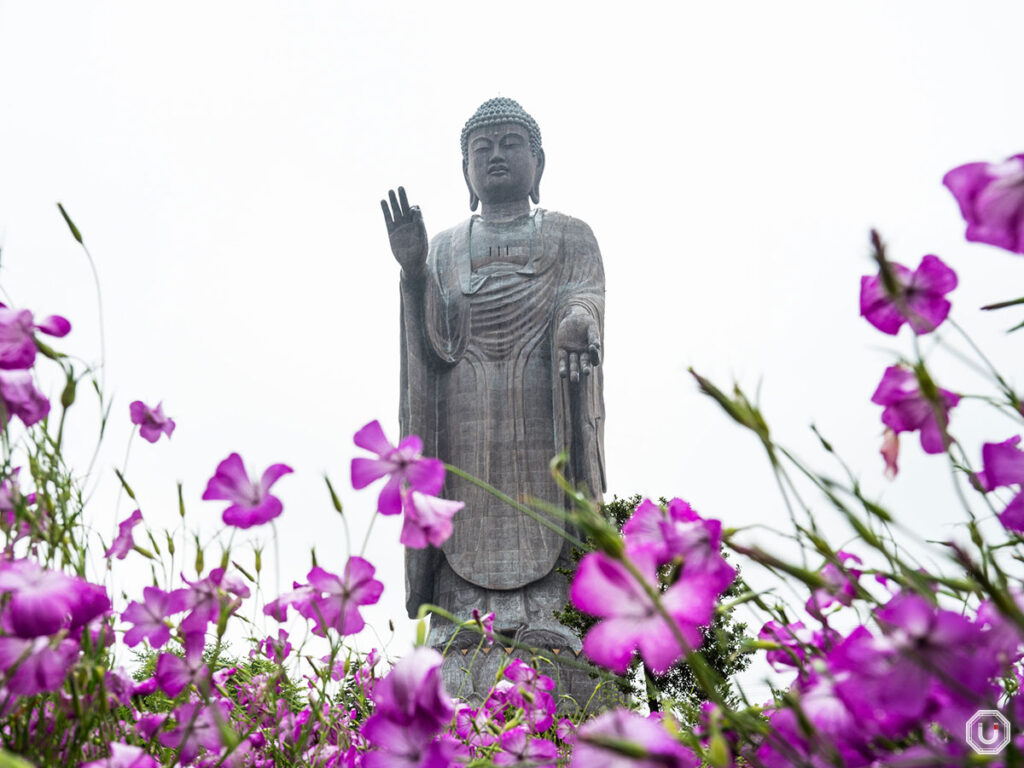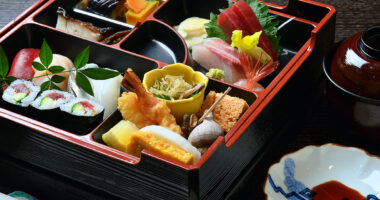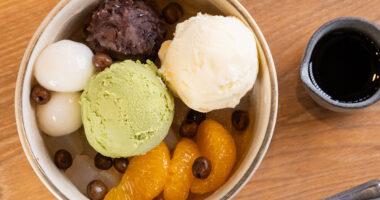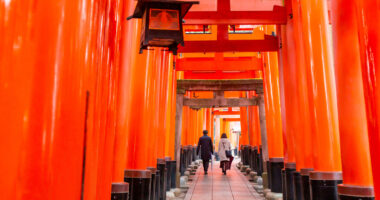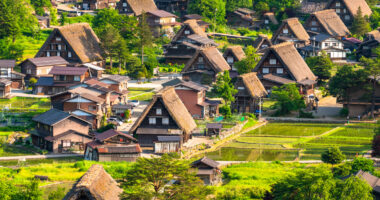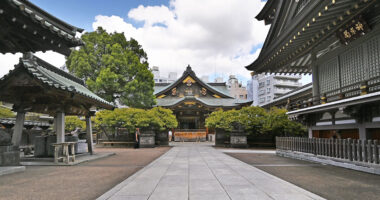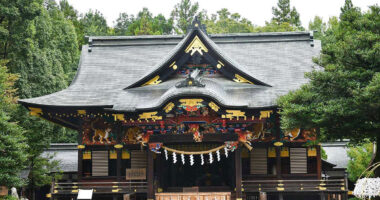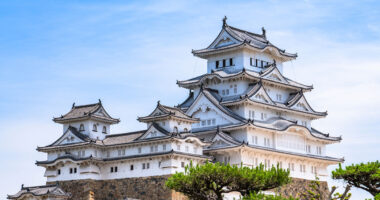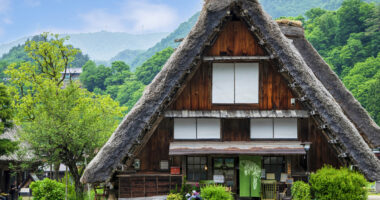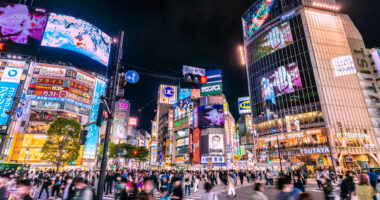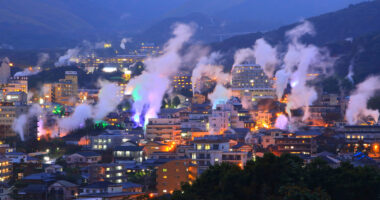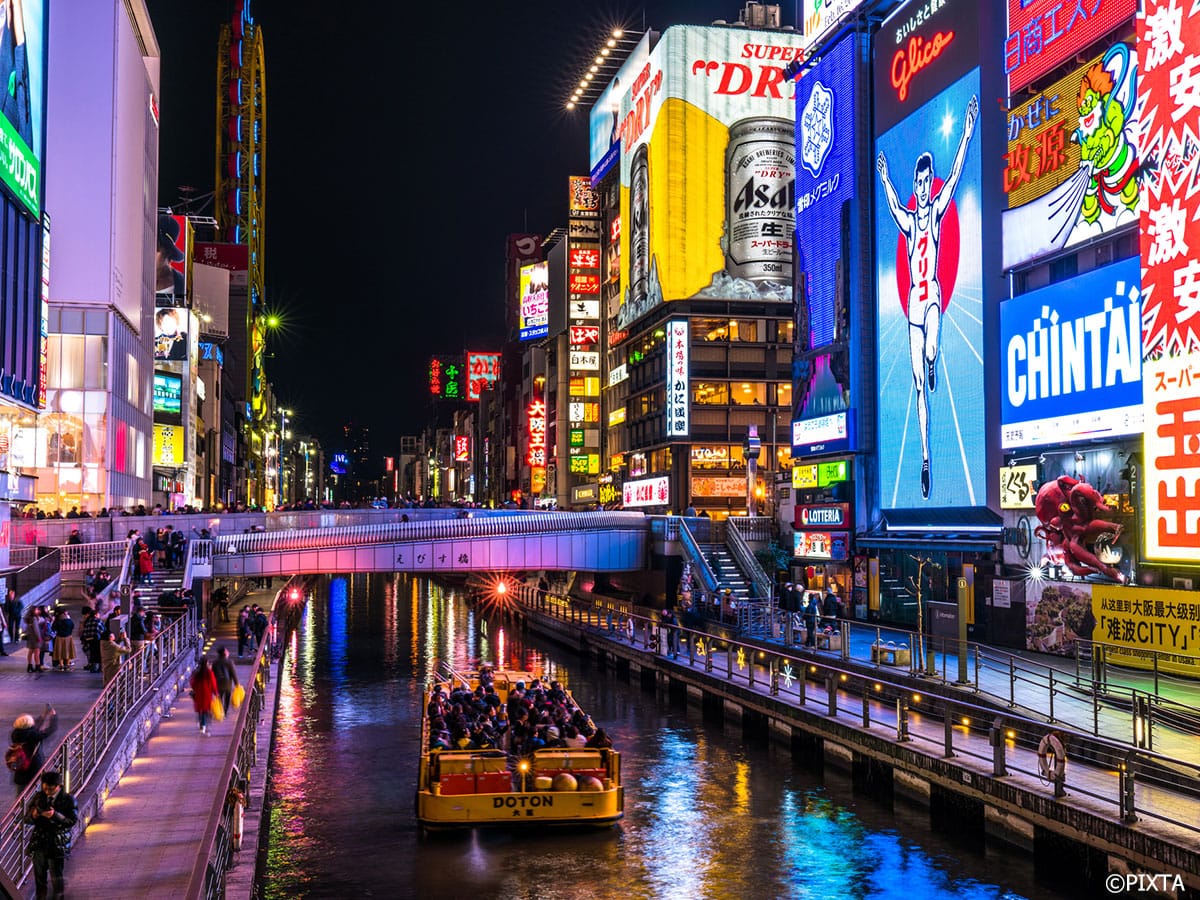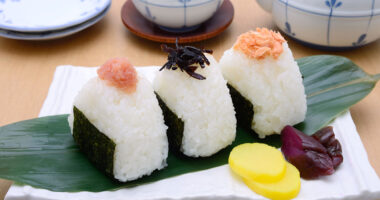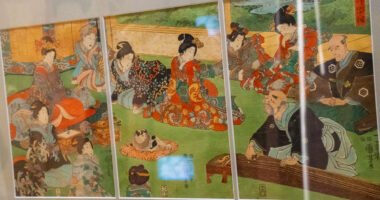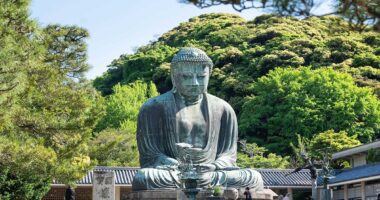Standing tall in Ushiku City, Ibaraki Prefecture, Ushiku Daibutsu is a towering statue of Amida Buddha, renowned for its overwhelming scale and presence.
Recognized by the Guinness World Records in 1995 as the world’s tallest bronze Buddha statue, this enormous figure attracts visitors not only from across Japan but also from countries throughout Asia, including Thailand and Taiwan, where it is revered as a sacred site.
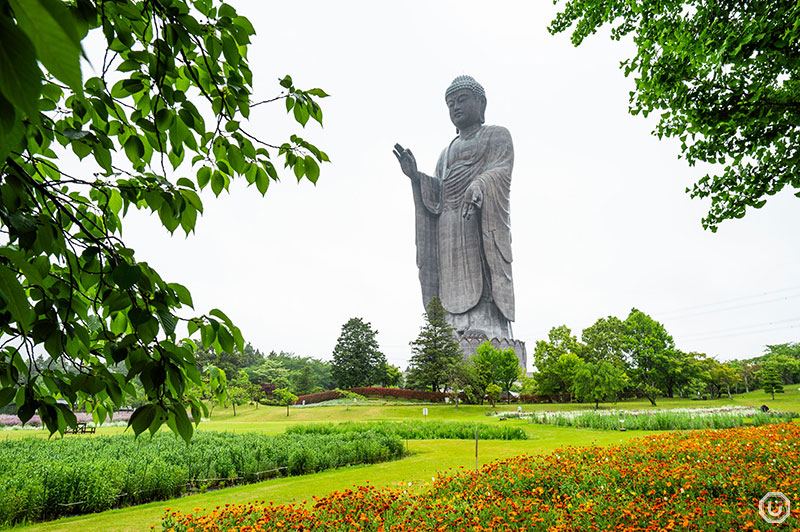
The Ushiku Daibutsu in Ushiku City, Ibaraki Prefecture
Set within peaceful garden grounds that change with the seasons, Ushiku Daibutsu offers plenty to see and experience even after your visit to the statue itself.
This article delves into the history, highlights, and best times to visit Ushiku Daibutsu.
- What is the Ushiku Daibutsu? Japan’s tallest Buddha statue, a Guinness World Record holder
- Photo tour of the Ushiku Daibutsu's highlights
- The World of Infinite Light and Life (Hikari no Sekai): a space illuminated by a single ray
- Room of Gṛdhrakūṭa (Ryōjusen no Ma): a view of Kanto from 85 meters high
- World of the Lotus Sanctuary (Rengezō no Sekai): a breathtaking golden chamber
- World of Gratitude and Thankfulness (Chīon-Hōtoku no Sekai): calm your mind through sutra copying
- Offering prayers and thanks to Amida Buddha inside the statue
- The best time to visit Ushiku Daibutsu
- Access to Ushiku Daibutsu: train, taxi, or car?
- Ushiku Daibutsu information
What is the Ushiku Daibutsu? Japan’s tallest Buddha statue, a Guinness World Record holder
Officially named the Ushiku Amida Buddha, the Ushiku Daibutsu was built by the Higashi Honganji branch of Jōdo Shinshū Buddhism. It stands in Ibaraki Prefecture, a region said to have ties to the sect’s founder, Shinran Shōnin.
Historical records indicate that Shinran Shonin once based his missionary activities in Ibaraki. Notably, Sainen-ji Temple in Kasama City is well known as the birthplace of Jodo Shinshu Buddhism.
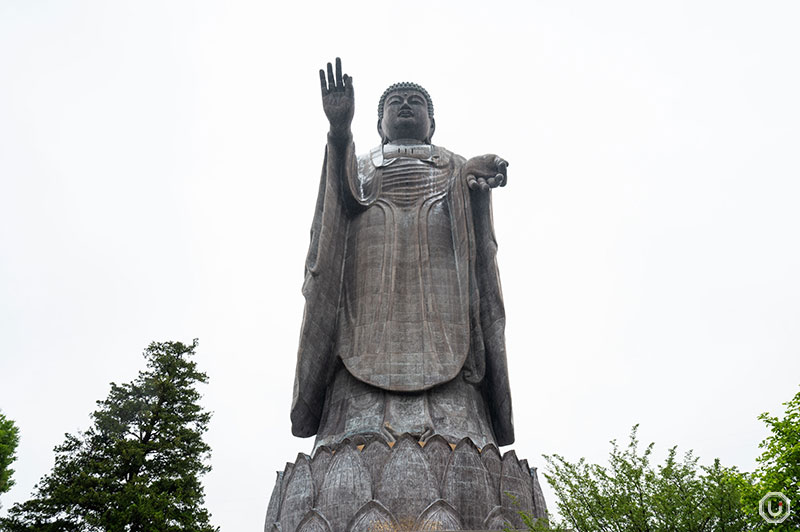
The construction of the Ushiku Daibutsu began in 1986 in Ibaraki Prefecture, where Shinran Shonin once lived. It was completed in 1993 after four years of work.
Including its base, the Ushiku Daibutsu stands 120 meters (394 feet) tall, making it the tallest bronze Buddha statue in the world as of May 2025. The height of 120 meters is said to symbolize both the 12 rays of light that Amida Buddha shines upon all living things and the vastness of his compassion.
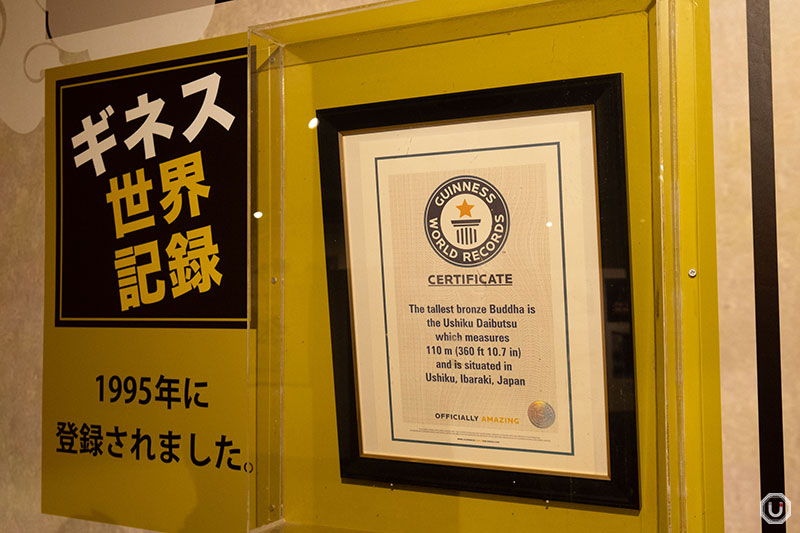
The certificate recognizing its Guinness World Record status in 1995
To put the Ushiku Daibutsu’s size into perspective, it is roughly three times taller than the Statue of Liberty in the U.S. (which is about 40 meters or 131 feet tall without its pedestal), and about eight times the height of the Great Buddha of Tōdai-ji in Nara, which stands at around 15 meters (49 feet).
Just the palm of the Ushiku Daibutsu’s left hand measures approximately 18 meters (59 feet)—large enough to fit the entire Great Buddha of Tōdai-ji within it.
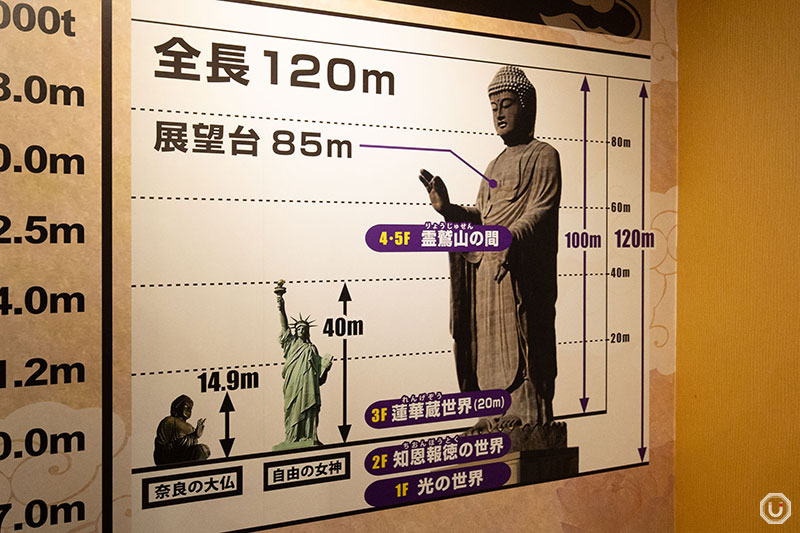
Comparison chart of the Statue of Liberty and the Great Buddha of Nara
Photo tour of the Ushiku Daibutsu’s highlights
The interior of the statue, constructed by Higashi Honganji Shrine, is known as the “Tainai” (literally “in the womb”) and is designed to represent the world of Buddhism.
The World of Infinite Light and Life (Hikari no Sekai): a space illuminated by a single ray
The first floor, known as the “The World of Infinite Light and Life,” (Hikari no Sekai) represents the darkness of human desires. Upon passing through this symbolic darkness, visitors enter a space softly illuminated by a single beam of light symbolizing Amitabha’s compassion.
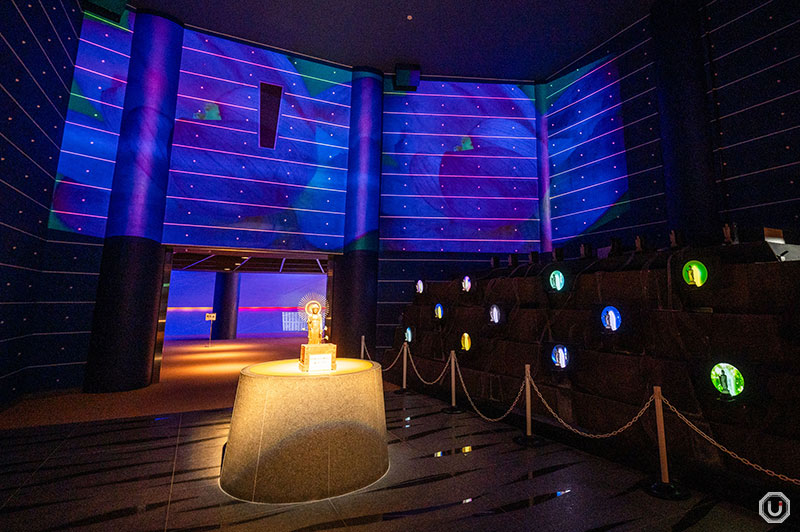
The World of Infinite Light and Life (Hikari no Sekai)
Beyond this area, visitors can explore the history behind the construction of the Ushiku Daibutsu, along with a life-sized model of the tip of its right big toe.
You can stand next to the model and take photos, making for a memorable experience.
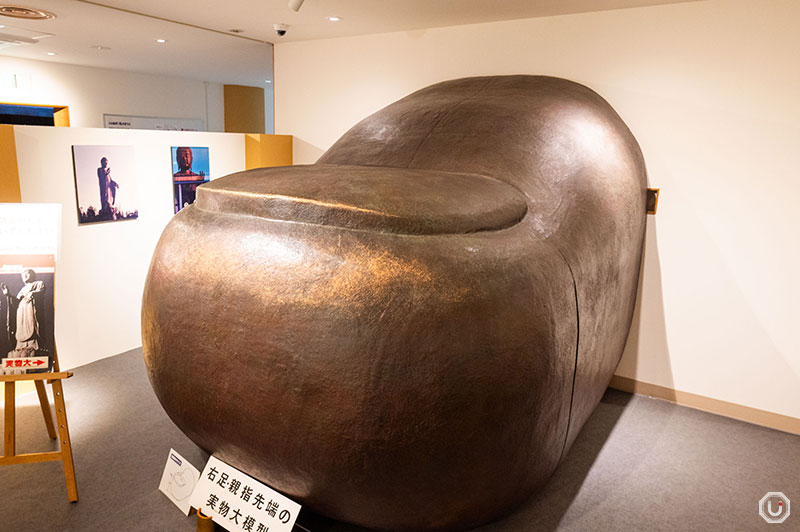
Life-size model of the tip of the Ushiku Daibutsu’s right big toe
Room of Gṛdhrakūṭa (Ryōjusen no Ma): a view of Kanto from 85 meters high
Afterwards, take the elevator up to a height of 85 meters above ground to the “Room of Gṛdhrakūṭa” (Ryōjusen no Ma) located near the chest of the Ushiku Daibutsu, which features the “Chest Observation Window.”
Named after Gṛdhrakūṭa(chamber of Ryo-ju-sen), also known in English as Holy Eagle Peak, in India, where the Buddha is said to have delivered sermons, this area houses busshari (sacred Buddhist relics).
With windows facing north, south, east, and west, visitors can look down below and truly appreciate the towering height of the Ushiku Daibutsu.
If the conditions are right, you can see landmarks like the Tokyo Skytree and Mount Fuji from the west-facing window, making this one of the most popular spots inside the statue.
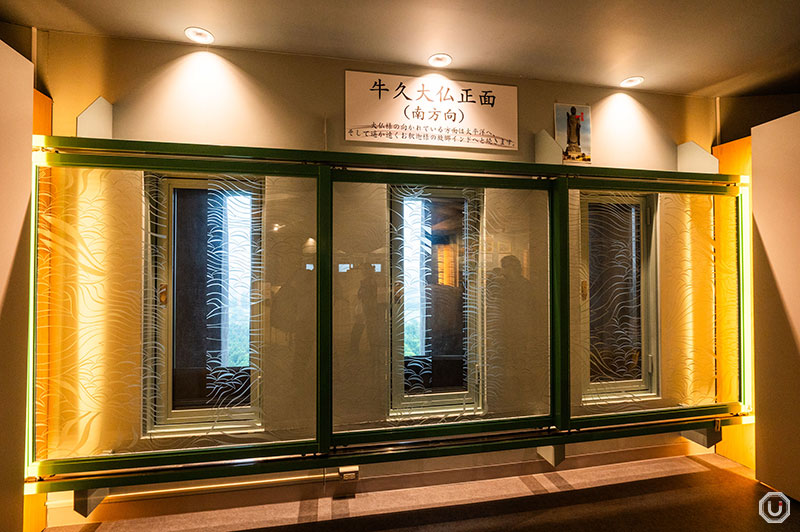
Room of Mt. Grdhrakuta (Ryōjusen no Ma), 85 meters high
World of the Lotus Sanctuary (Rengezō no Sekai): a breathtaking golden chamber
Take the elevator down to the third floor, where you’ll enter the “World of the Lotus Sanctuary” (Rengezō no Sekai).
Surrounded by over 3,000 golden Buddha statues, this space is both spectacular and otherworldly.
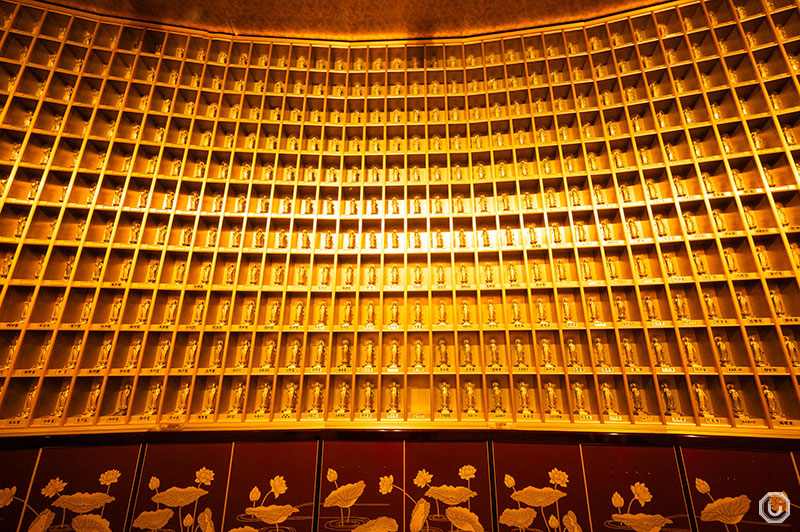
World of the Lotus Sanctuary (Rengezō no Sekai)
Visitors can offer kaimyō (posthumous Buddhist names) to the enshrined Buddhas, where they will be honored and memorialized for eternity.
Each day, monks recite sutras here, making it a place for quiet reflection and prayer—a space to renew one’s gratitude for family and ancestors.
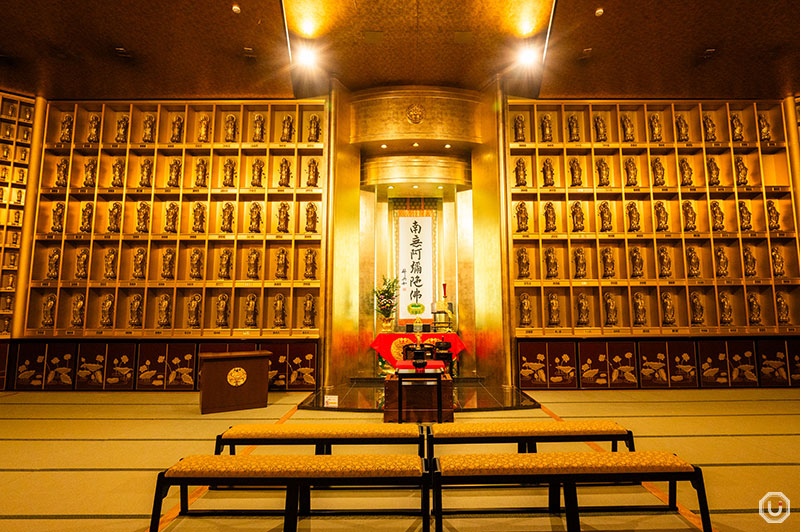
Sutras are chanted daily in the World of the Lotus Sanctuary
World of Gratitude and Thankfulness (Chīon-Hōtoku no Sekai): calm your mind through sutra copying
On the second floor is the “World of Gratitude and Thankfulness” (Chīon-Hōtoku no Sekai), where visitors can try shakyō (sutra copying), with 77 desks available. Sutra copying is the traditional practice of hand-transcribing Buddhist scriptures as a form of meditation, devotion, and merit-making.
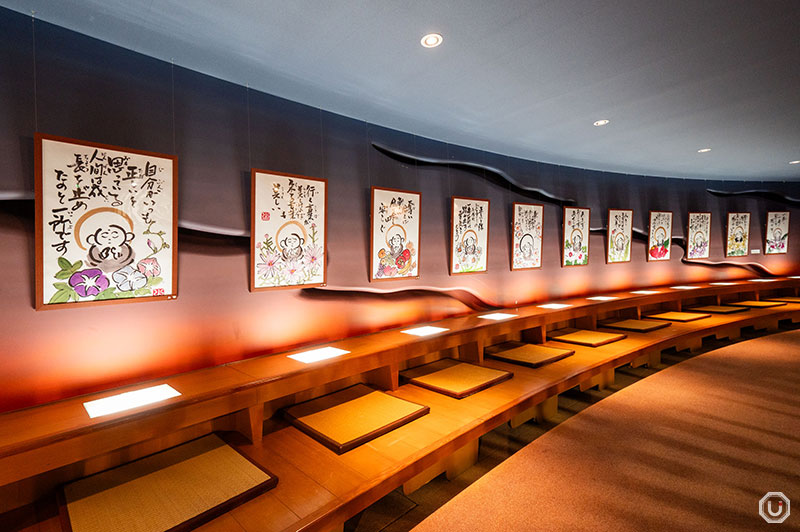
Sutra copying at the World of Gratitude and Thankfulness (Chīon-Hōtoku no Sekai)
You can try copying the ekō-mon (dedication verse), which takes over 20 minutes, for 500 JPY, or the sanseige (three vows verse), which takes over an hour, for 1,000 JPY.
The format involves tracing over templates placed underneath, making it accessible for beginners to easily participate in the sutra copying experience.
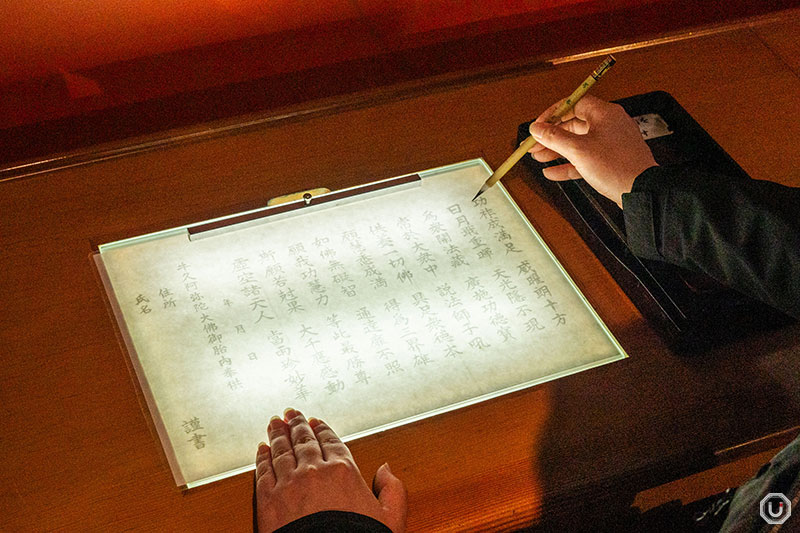
Copying sets are provided free of charge
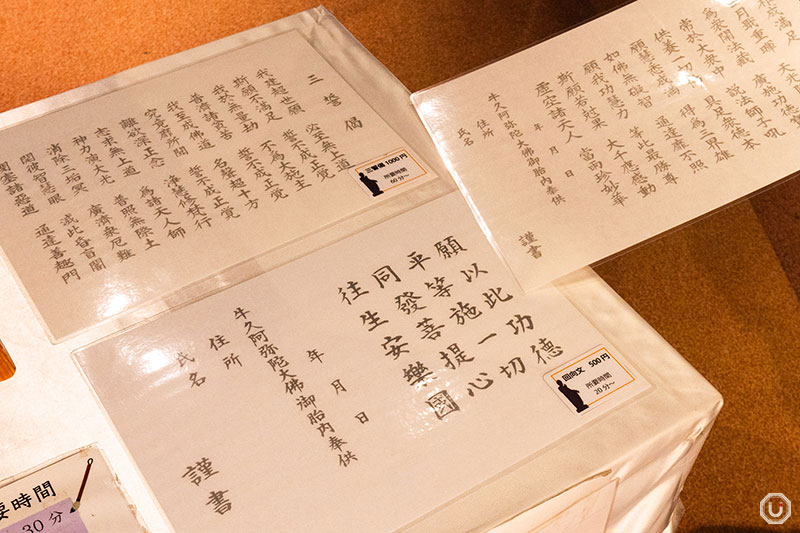
(top left & top right) sanseige; (bottom) eko-mon
Offering prayers and thanks to Amida Buddha inside the statue
Excluding the sutra copying experience, it takes about an hour to explore the interior of the Ushiku Daibutsu. You can also offer a letter called a ganshōmon, in which you write your wishes or words of gratitude to Amida Buddha.
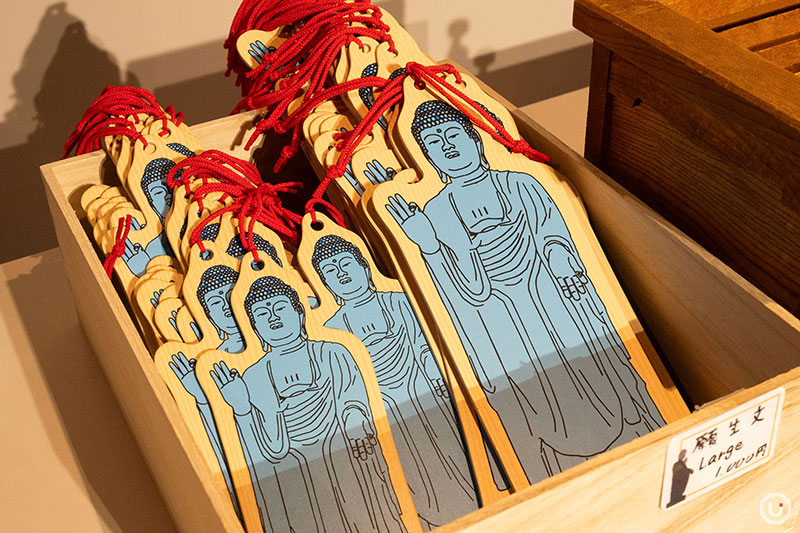
A ganshomon letter depicting the Ushiku Daibutsu
The ganshomon letter featuring an illustration of the Ushiku Daibutsu is available in two sizes: mini for 500 JPY and large for 1,000 JPY.
These letters, written in a variety of languages, are offered to Amida Buddha—highlighting just how popular the Ushiku Daibutsu is among visitors from around the world.
The best time to visit Ushiku Daibutsu
Whether you’re coming for the statue or exploring the Pure Land garden, there’s plenty to see and enjoy throughout the year.
Behind the statue, the “Monkey Show” hosts three shows on weekdays—at 11:00, 13:00, and 14:30.
On weekends and national holidays, the number of shows varies by season, with four performances held daily: at 11:00, 12:30, and 14:00, plus an additional show at 15:20 from October to February, or at 15:30 from March to September. Please note that in December and from the third week of January through February, shows are only held on weekends and holidays.
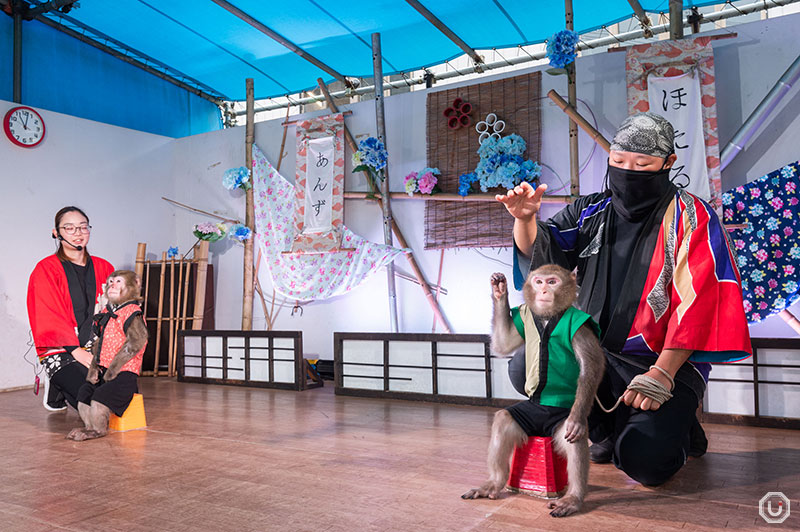
The Monkey Show is free of charge
The charming performance by two adorable monkeys is so entertaining that the 20-minute show feels like it flies by.
The adjacent “Petting Zoo” is open only on Sundays and national holidays, and is closed in December and February. Visitors can feed the animals, making it a fun spot for both kids and adults.
In addition, the Pure Land garden surrounding the Ushiku Daibutsu is known for its beautiful seasonal flowers and is a popular photo spot.
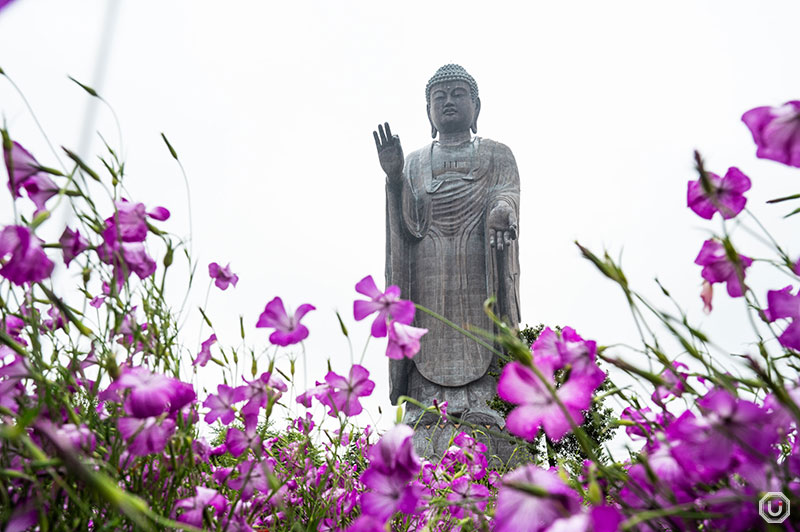
The garden in May 2025
A variety of flowers bloom throughout the year, each season offering something different. Here are the highlights by season:
- Spring: This is the peak season for many flowers. In early April, cherry blossoms and moss phlox reach full bloom, followed by poppies and godetia in mid-April.
- Summer: June brings hydrangeas into bloom. From mid-July to late August, blue salvia and cockscomb paint the garden in vibrant colors.
- Autumn: Cosmos bloom beautifully in autumn, with October being the best time to see them. The garden, awash in vivid cosmos flowers, looks like a scene from the Pure Land paradise.
- Winter: The clear blue skies make the Ushiku Daibutsu look even more majestic. While flowers aren’t in bloom, the garden takes on a serene beauty when covered in snow.
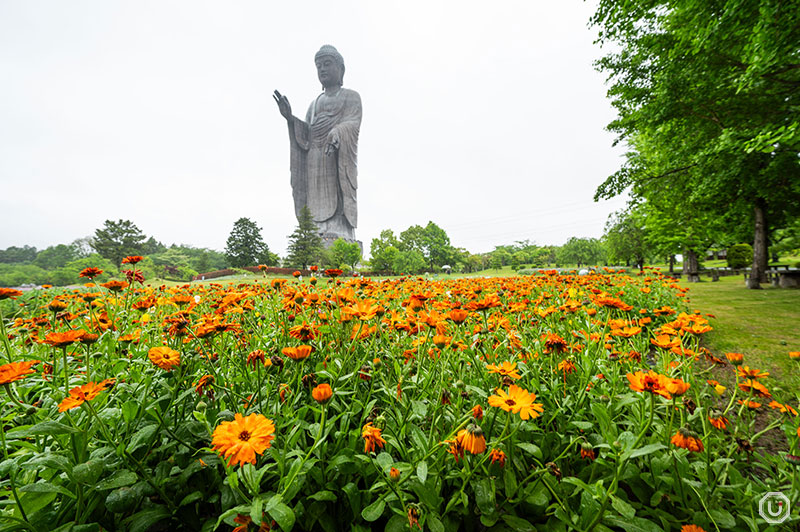
The garden in May 2025
Access to Ushiku Daibutsu: train, taxi, or car?
While bus tour packages that include visits to Ushiku Daibutsu are available, if you plan to visit individually, you can choose to travel by train, car, or taxi.
Consider the pros and cons of each transportation method to select the best option for you.
Train: affordable and smooth access when combined with bus
After getting off at Ushiku Station on the JR Jōban Line, head to the east exit of the station. From platform number 2, take the Kanto Railway Bus bound for Ushiku Jōen or Ushiku Daibutsu.
The bus uses a post-payment ticket system or accepts IC cards. On weekdays, the fare is 730 JPY (tax included).
On weekends and holidays, take the bus bound for Ami Premium Outlets. This bus costs 560 JPY one way (tax included).
From major city center stations like Shinjuku, Shibuya, or Ueno, it takes about 1.5 to 2 hours by train to Ushiku Station. The bus ride from Ushiku Station to Ushiku Daibutsu takes approximately 25 to 35 minutes.
- Pros: The most affordable option compared to other transportation methods.
- Cons: On weekdays, the bus runs only about three times a day, limiting sightseeing time. On weekends and holidays, there are eight trips per day.
Taxi: ideal for groups
After getting off at Ushiku Station or Hitachino-Ushiku Station on the JR Jōban Line, head to the taxi stand at the east exit of the station. From either station, it takes about 15 to 20 minutes by taxi to reach Ushiku Daibutsu.
The estimated fare is around 4,000 to 4,700 JPY (tax included).
If you’re visiting with a group, splitting the fare makes it relatively affordable, and taxis offer more flexibility than the bus schedule.
However, since there are few taxis available around the stations, it’s recommended to arrange a taxi in advance using a dispatch service.
- Pros: Convenient access to Ushiku Daibutsu without worrying about time. For groups of four or more, the cost is comparable to taking the bus.
- Cons: More expensive for solo travelers.
Car: convenient for visiting nearby sightseeing spots
If driving from Tokyo via the expressway, take the Metropolitan Inter-City Expressway (Ken-Ō Expressway) and exit at Ami-Higashi Interchange. It’s about a three minute drive from there to Ushiku Daibutsu.
Ushiku Daibutsu offers a large parking lot with space for approximately 800 passenger cars, and parking is free of charge.
Nearby, there are large shopping facilities like Ami Premium Outlets and leisure spots such as Komorebi Ibaraido Forest (a nature-themed theme park). Driving makes it easy to visit these along with Ushiku Daibutsu.
- Pros: Easy access to other tourist spots in Ibaraki Prefecture besides Ushiku Daibutsu.
- Cons: Requires a valid driver’s license.
Ushiku Daibutsu information
| Name | 牛久大仏 Ushiku Daibutsu |
|---|---|
| Address | 2083 Kuno-cho, Ushiku City, Ibaraki Prefecture
|
| Access | Train & Bus From the JR Jōban Line Ushiku Station East Exit, approx. 25–35 minutes by Kanto Railway Bus from platform No. 2 (weekdays) bound for Ushiku Jōen / Ushiku Daibutsu (weekends & holidays) bound for Ami Premium Outlets Train & Taxi Approx. 15–20 minutes from the JR Jōban Line Ushiku Station East Exit or Hitachino-Ushiku Station East Exit By Car Approx. 3 minutes from Ami-Higashi Interchange on the Metropolitan Inter-City Expressway (Ken-O Expressway) |
| Phone | 029-889-2935 |
| Visiting Hours | Mar-Sep. Mon-Fri. 9:30-17:00, Sat-Sun. & nat’l holidays Oct-Feb. 9:30-16:30 last admission 30 minutes before closing time for garden-only tickets, and 45 minutes before closing for set tickets that include entry into the Ushiku Daibutsu interior and garden |
| Sacred items | None |
| Goshuin | Mar-Sep. Mon-Fri. 9:30-16:30, Sat-Sun. & nat’l holidays 9:30-17:00 Oct-Feb. 9:30-16:00 available only to those with a garden ticket or all included ticket |
| Omikuji | None |
| Admission fee | Garden ticket Adults 500 JPY 400 JPY for groups of 15 or more, or for visitors with a disability certificate (must present certificate) Children 300 JPY 200 JPY for groups of 15 or more, or for visitors with a disability certificate (must present certificate) All included ticket (garden and Buddha interior) Adults 800 JPY 600 JPY for groups of 15 or more, or for visitors with a disability certificate (must present certificate) Children 400 JPY 300 JPY for groups of 15 or more, or for visitors with a disability certificate (must present certificate) |
| Official website | https://daibutu.net/index.html |
| Other information |
|
※The information in this article is current as of May 2025.
